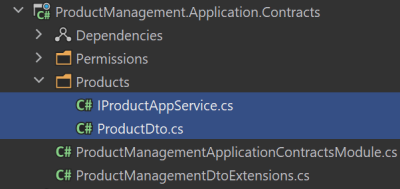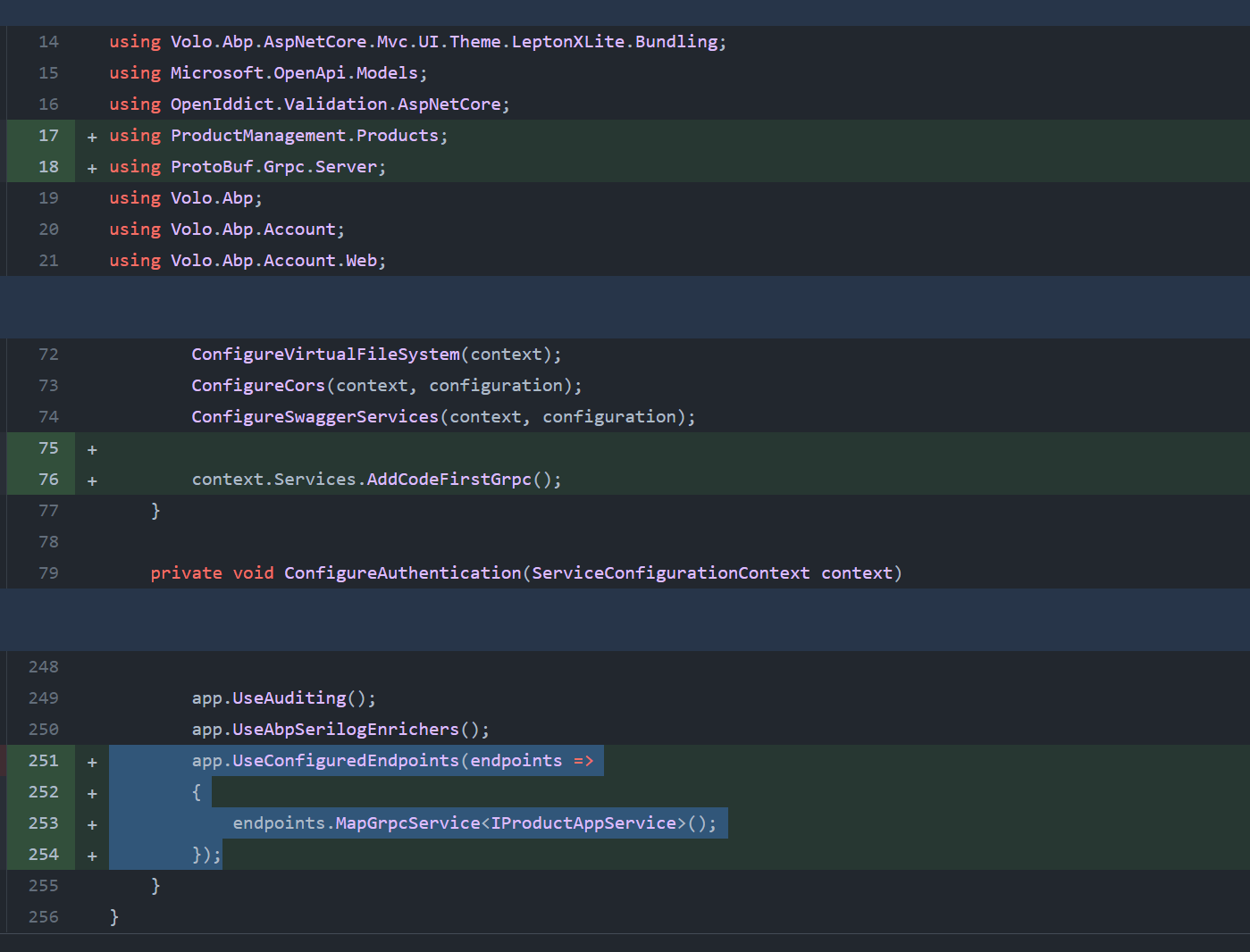Using gRPC with the ABP Framework
gRPC defines itself as an open source, language agnostic, universal, high-performance Remote Procedure Call (RPC) framework.
In this article, I will show you how to create a gRPC service and consume it from a console application with the ABP Framework. While the client application is console in this article, it can easily be a service consuming another service in a microservice system.
This article will be a step by step tutorial. I wrote the article based on Microsoft's Code-first gRPC services and clients with .NET document. You can read that document for more details about gRPC and the code-first approach.
Creating the Application
Install the ABP CLI if you haven't installed it yet:
dotnet tool install -g Volo.Abp.Cli
or update to the latest version if you've already installed an old version:
dotnet tool update Volo.Abp.Cli -g
Create an empty folder, open a command-line terminal and type the following command in the terminal window to create a new ABP solution using the ABP CLI:
abp new ProductManagement -u blazor -t app --preview
I've created an application with the Blazor UI, but the UI is not important for this tutorial, you can select your favorite UI option.
Open the Solution
Open the solution in your favorite IDE. I like Rider, but Visual Studio, VS Code or any other IDE perfectly works. The following figure shows the solution structure in Rider:

Run the ProductManagement.DbMigrator project (a console application) to create the database and seed the initial data.
Defining the Service Contract
We are starting by defining the service contract and DTO classes that will be shared between the server and the client applications.
Create a Products folder in the ProductManagement.Application.Contracts project and add a new interface named IProductAppService:
using System.Collections.Generic;
using System.ServiceModel;
using System.Threading.Tasks;
using Volo.Abp.Application.Services;
namespace ProductManagement.Products;
[ServiceContract]
public interface IProductAppService : IApplicationService
{
Task<List<ProductDto>> GetListAsync();
}
Your IDE will complain about the [ServiceContract] attribute, but it is necessary for the contract-first gRPC library we will be using later. So, add the System.ServiceModel.Primitives NuGet package to the ProductManagement.Application.Contracts project, and it should be fixed. You can simply edit the ProductManagement.Application.Contracts.csproj file and add the following line in an ItemGroup tag:
<PackageReference Include="System.ServiceModel.Primitives" Version="4.7.0" />
Or you can use your IDE to find and add that NuGet package, it is up to you.
I've also used the ProductDto class, but haven't defined it yet. Create a new class in the same folder with the IProductAppService file:
using System;
using System.Runtime.Serialization;
namespace ProductManagement.Products;
[DataContract]
public class ProductDto
{
[DataMember(Order = 1)]
public Guid Id { get; set; }
[DataMember(Order = 2)]
public string Name { get; set; }
}
The [DataContract] and [DataMember] properties are needed for serialization. In gRPC, property serialization orders are important, because property names are not transferred to the target application, to keep the serialized data small.
After adding these classes, the ProductManagement.Application.Contracts project should look as in the following figure:

The contracts part is over. We actually didn't have any dependency to gRPC at that point. Our service and DTOs are pretty plain classes, except a few standard attributes, which are already defined in the .NET Core framework. Now, we can implement the IProductAppService.
Implementing the Service
We are implementing the application services in the ProductManagement.Application project. So, add a new Products folder to that project and define a ProductAppService class inside it:
using System;
using System.Collections.Generic;
using System.Threading.Tasks;
namespace ProductManagement.Products;
public class ProductAppService : ProductManagementAppService, IProductAppService
{
public async Task<List<ProductDto>> GetListAsync()
{
return new List<ProductDto>
{
new ProductDto { Id = Guid.NewGuid(), Name = "Product 1" },
new ProductDto { Id = Guid.NewGuid(), Name = "Product 2" },
};
}
}
This is a pretty standard, plain application service class. All the ABP application service features (validation, audit logging, unit of work, etc.) are available. You can inject repositories and perform database queries. To keep this article simple, I am returning hard-coded data from here.
ProductManagementAppServiceis a base class coming in the ABP startup template. While you don't have to inherit from it, it provides useful base properties and methods you typically need in an application service.
The application service part is over. Again, we didn't write any gRPC specific code. Don't worry, we will write in the next section.
Configuring the gRPC Server
In this solution, ProductManagement.HttpApi.Host is the project that configures and runs the server-side application. So, we will make changes in that project.
First, add the protobuf-net.Grpc.AspNetCore NuGet package to the ProductManagement.HttpApi.Host project:
<PackageReference Include="protobuf-net.Grpc.AspNetCore" Version="1.0.177" />
Then open the ProductManagementHttpApiHostModule.cs file, find the ConfigureServices method and add the following line into this method:
context.Services.AddCodeFirstGrpc();
This will register code-first gRPC services to the dependency injection system. Then find the app.UseConfiguredEndpoints() line in the OnApplicationInitialization method and change it as shown below:
app.UseConfiguredEndpoints(endpoints =>
{
endpoints.MapGrpcService<IProductAppService>();
});
We've configured the IProductAppService to handle gRPC requests to that service. The following figure shows the whole change done in the ProductManagementHttpApiHostModule class:

gRPC handles requests with the HTTP/2 protocol and should listen an endpoint other than the default HTTP endpoint used by the application. We can easily configure the Kestrel server to listen two endpoints, one for our HTTP APIs, the other one for gRPC services. Add the following configuration inside the appsettings.json file of the ProductManagement.HttpApi.Host project:
"Kestrel": {
"Endpoints": {
"Https": {
"Url": "https://localhost:44388",
"Protocols": "Http1AndHttp2"
},
"gRPC": {
"Url": "https://localhost:10042",
"Protocols": "Http2"
}
}
}
Note that https://localhost:44388 may be different for your case, since ABP CLI assignes a random port while you're creating a new solution. You can check your port by running the ProductManagement.HttpApi.Host project and looking at the address bar on your browser.
The server-side configuration is done. It is ready to receive gRPC requests. Now, we can change the client to consume the gRPC service we've created.
Implementing the Client Side
The ABP startup solution template comes with a console application to test consuming your HTTP APIs. For this example, the project is named as ProductManagement.HttpApi.Client.ConsoleTestApp and located under the test folder in the solution.
First, add the Grpc.Net.Client and the protobuf-net.Grpc NuGet packages to the ProductManagement.HttpApi.Client.ConsoleTestApp project.
<PackageReference Include="Grpc.Net.Client" Version="2.49.0-pre1" />
<PackageReference Include="protobuf-net.Grpc" Version="1.0.177" />
Now, open the ClientDemoService.cs file under the ProductManagement.HttpApi.Client.ConsoleTestApp project and change its contents with the following code block:
using System;
using System.Threading.Tasks;
using Grpc.Net.Client;
using ProductManagement.Products;
using ProtoBuf.Grpc.Client;
using Volo.Abp.DependencyInjection;
namespace ProductManagement.HttpApi.Client.ConsoleTestApp;
public class ClientDemoService : ITransientDependency
{
public async Task RunAsync()
{
using (var channel = GrpcChannel.ForAddress("https://localhost:10042"))
{
var productAppService = channel.CreateGrpcService<IProductAppService>();
var productDtos = await productAppService.GetListAsync();
foreach (var productDto in productDtos)
{
Console.WriteLine($"[Product] Id = {productDto.Id}, Name = {productDto.Name}");
}
}
}
}
We are simply creating a gRPC channel, then creating a client proxy for the IProductAppService service. Then we can call its method just like local method calls. You can run the applications to test it.
Run the Applications
First run the ProductManagement.HttpApi.Host application. It should show a Swagger UI as shown below:

If you see that page, it means your server-side is up and running. Now, you can run the ProductManagement.HttpApi.Client.ConsoleTestApp console application to call the gRPC service defined on the server.
The test console application should produce an output as shown below:

As you see, products are returned from the server. That's all, you've done it!
Conclusion
In this article, I've used the code-first approach to implement a gRPC server and consume it in a client application. Code-first approach is very practical if both of your client and server applications are built with .NET. By the help of ABP's layered solution structure, we even didn't add any gRPC dependency into our server-side and contracts. We've just configured gRPC in the hosting side, with a small amount of code.
gRPC on .NET has different approaches, features, configurations and more details. I suggest you to read Microsoft's documentation to learn more about it. All the approaches can work with the ABP Framework. Enjoy coding!
The Source Code
You can find the completed source code here: https://github.com/abpframework/abp-samples/tree/master/GrpcDemo2
You can also see all the changes I've done in this article here: https://github.com/abpframework/abp-samples/pull/200/files


























































Comments
Engincan Veske 170 weeks ago
Great article, thanks!
Super Lau 169 weeks ago
Nice.
Ivan Semenov 162 weeks ago
Thanks for the great article!
Halil İbrahim Kalkan 162 weeks ago
I am glad you liked it :)
Gökhan Atılgan 150 weeks ago
That was great article, thank you for that. I have some question about that. What about external clients without ABP?
Halil İbrahim Kalkan 150 weeks ago
If the external client is .NET, then you can still share the application service interfaces & DTOs to the client, and it can call your services. If the client is not .NET, then you should prepare proto files for your client.
developer@hola.health 81 weeks ago
this applcaition only working in "dotnet run" cmd using kestral server, how to run it using visual studio and get response form grpc server ?
Enis Necipoğlu 43 weeks ago
If kestrel is configured to use HTTP/2, yes it'll work with all the scenarios